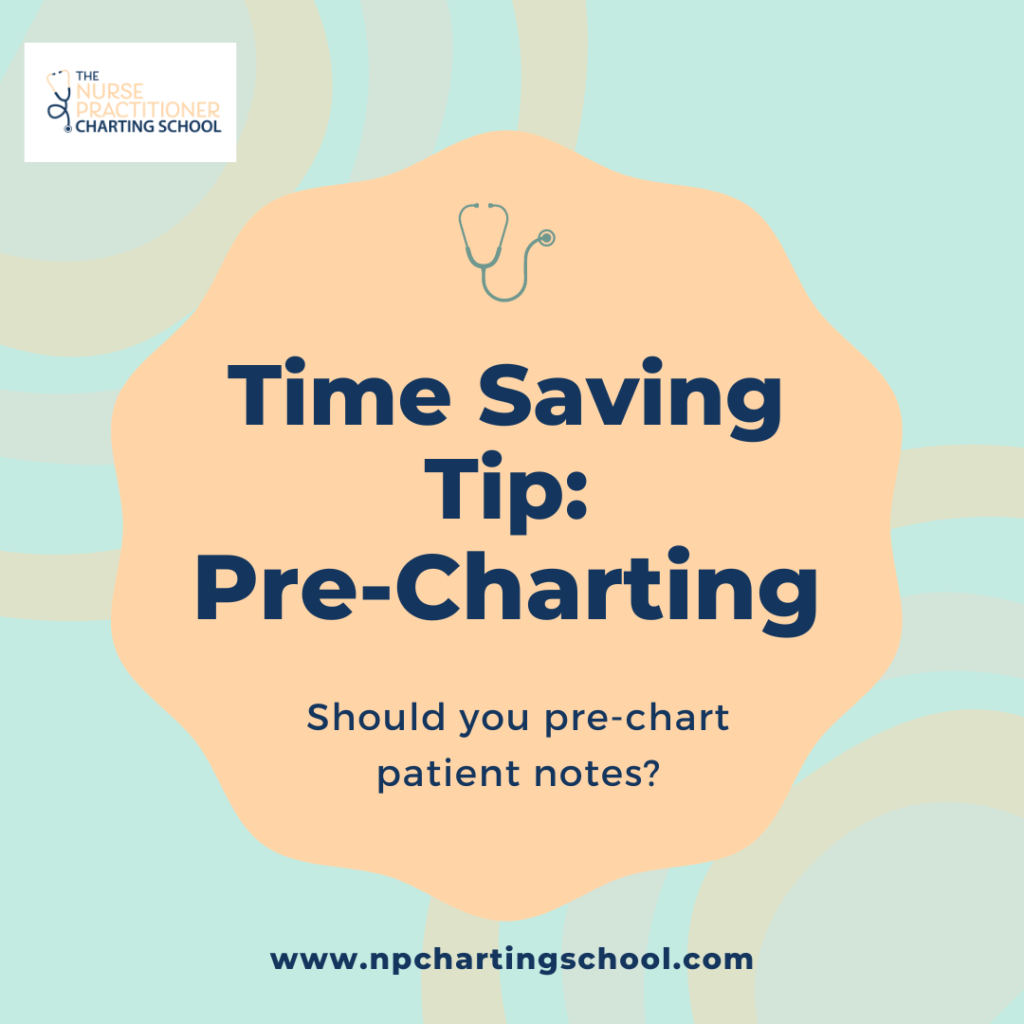To pre-chart or not to pre-chart, that is the question.
First off, let us define “pre-charting” and when a nurse practitioner might use this potential time saving tip.
Pre-charting is starting on the chart note before seeing the patient. Many nurse practitioners find it helpful to review a hospital stay summary, past laboratory results, or the previous patient encounter. The nurse practitioner then begins documenting the chart note.
This is considered pre-charting because the nurse is completing this work prior to seeing the patient.
While I encourage each nurse practitioner to do what is best for their own practice, this article will discuss some pros and cons of pre charting.
Situations when pre-charting might be a waste of time.
The patient is a no show.
Think about how frustrating it is for the nurse practitioner to do all that extra work ahead of time, only to have the patient not show up for their scheduled appointment. The nurse practitioner wasted their time reviewing the past medical documents and starting on the chart note.
The patient comes in for a different chief complaint.
How many times has a patient come in to be seen for one thing when only to find out they are having more or different symptoms/complaints. For example, the chief complaint may be “sore throat.” But the patient comes in and also complains of shortness of breath, fever, and a productive cough.
Maybe you thought the diagnosis would be an easy pharyngitis when now you need to do more work to check for pneumonia. We thought we were saving time by pre-charting an acute pharyngitis visit when we end up having to go back and change/add information.
The patient comes in for an additional chief complaint.
As nurse practitioners, we’ve all been there. Our hand is on the door knob, ready to walk out of the patient room when we hear, “I just have one more quick question.” The additional chief complaint requires the nurse practitioner’s time and attention.
Yes, our pre-charting helped with one of the diagnoses, but we now have to start over with the history of present illness (HPI) for any additional complaints or diagnosis.
We just looked at three different scenarios when pre-charting was a waste of time for the nurse practitioner.
Ways nurse practitioners can utilize pre-charting to save us time.
Expedites the charting for the complicated cases.
I worked with a nurse practitioner who found pre-charting to be very beneficial for her situation. She would spend a few minutes first thing in the morning to review her scheduled patients. This nurse practitioner would identify which patient would be the most complex and begin working on their chart note.
These patients were generally follow-up patients and ones that rarely canceled their appointment, so the nurse practitioner was confident to utilize her time for pre-charting.
This greatly benefited this APRNs flow during the day. Once she saw the patient, she updated or changed any information and signed the chart! This nurse practitioner found it very rewarding to have these complex patient’s notes signed and kept her motivated for the rest of the clinic day!
Saves time when reviewing medical records.
I will pre-chart on certain patients. If I review medical documents following a hospitalization and that patient is on my schedule, I will complete pre-charting. For me, it is much easier to take a few notes and formulate the history of present illness (HPI) as I am reading the hospital notes. It saves me time instead of having to go back and reread the hospital records.
Works well for hospitalized patients.
If you are a nurse practitioner working in a hospital setting, pre-charting can be very valuable. These hospitalized patients will not be a “no show” or cancel last minute. There are also previous chart notes from yesterday’s encounter, specialist notes, or nursing notes. When the nurse practitioner is reviewing the notes, they can enter the information and update into the current day’s chart note.
This will save a ton of time from having to remember or review what the other healthcare providers notes said. Then it is much easier to make any updates or changes after seeing the patient.
Pre-charting right before the patient encounter.
I will pre-chart on all of my clinic patients right before walking into the patient room. Once the nurse/medical assistant (MA) gets the patient checked in, I will pre-chart. I utilize templates in my charting system, so pre-charting for me is opening a chart note and having the charting system pull across the information in the template.
This helps that I have the note already open and the “normals” in the note (my template has a “normal” review of systems and physical exam). My template also pulls the patient’s home medications, past medical history, allergies, and vital signs from what was reviewed by the nurse/MA.
So before I walk in to see the patient I already have a chart note halfway done. It is much easier to change any abnormal review of systems or physical exam, add in any diagnostic data, and create the treatment plan.
This type of pre-charting helps me to finish the chart note right after the patient encounter.
Give pre-charting a try!
I think some areas of healthcare work very well such as hospitalists, specialty clinics, and sometimes primary care. Pre-charting is a little more difficult for urgent care or emergency setting (unless this is a recurring issue or you have access to other providers past medical documentation). But I do think there is value in pre-charting and nurse practitioners can utilize it as a time saving tip!
Check out The Time Management and Charting Tips Course for other tips to help you STOP charting at home!

Erica D the NP is a family nurse practitioner and The Nurse Practitioner Charting Coach. Erica helps nurse practitioners STOP charting at home! Erica created The Nurse Practitioner Charting School to be the one stop for all documentation resources created specifically for nurse practitioners. Learn more at www.npchartingschool.com
Follow on Facebook: The Nurse Practitioner Charting SchoolAnd on Instagram: @npchartingschool
Free training: 4 charting tips to help nurse practitioners get their time back! Sign up here!



